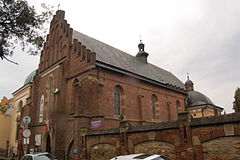Oświęcim Chapel
| Oświęcim Chapel | |
|---|---|

The chapel is visible on the left.
|
|
| General information | |
| Architectural style | Baroque |
| Town or city | Krosno |
| Country | Poland |
| Construction started | May 2, 1647 |
| Completed | October 8, 1648 |
| Client | Stanisław Oświęcim |
| Design and construction | |
| Architect | Vincenzo Petroni |
The Oświęcim Chapel (Polish: Kaplica Oświęcimów), dedicated to the Blessed Virgin Mary and St. Stanislaus of Szczepanów, is an extension to the Gothic Franciscan Church in Krosno (), Poland. Founded in 1647–1648 by a prominent representative of the Oświęcim family, it is also commonly known as the "Chapel of Love" (Polish: Kaplica Miłości). Associated with the romantic legend of Stanisław Oświęcim's love for his sister Anna, the building is one of the finest artistic achievements of its era. It represents a type of early Baroque burial chapel built on a square plan, with a dome topped by a lantern inspired by the early Renaissance Sigismund's Chapel.
The Oświęcim Chapel was built from May 2, 1647 til October 8, 1648. The walls were adorned with portraits of Stanisław Oświęcim and Anna Oświęcimówna, their father Florian Oświęcim and his two wives Barbara z Szamotów Oświęcimowa and Regina ze Śląskich Oświęcimowa, along with a portrait of Jan Oświęcim vicecapitaneus, Bielsko cupbearer and the judge of Sanok.
The designer of the chapel was Vincenzo Petroni from Milan. The rich stucco decoration was the work of the most outstanding stucco decorator of 17th-century Poland, Govanni Battista Falconi. The chapel was built on a square plan, with a dome topped by a lantern. At the entrance, there is a richly carved marble portal and a decorative grille.
The elaborate floral designs are enriched with winged putti. The decoration of the interior is not typically religious as it glorifies the founding family. The coat of arms and military insignia invoke the Oświęcims' noble traditions.
The main furnishing is the altar from 1890 (a faithful copy of a mid-17th century original) with ornaments, woodcuts and paintings dating from the chapel's foundation. The central painting depicts St. Stanislaus resurrecting the deceased knight Piotr with Stanisław and Anna in the background.
...
Wikipedia
